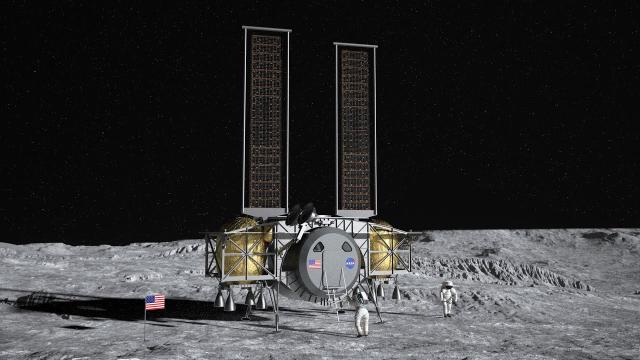As NASA prepares to return humans to the Moon in 2024, the space agency has decided to take the private route, selecting three U.S. companies to develop an astronaut landing system.
NASA announced yesterday that Blue Origin, Dynetics, and SpaceX will receive a combined $US967 ($1,484) million in funding to develop a human landing system for the Artemis Moon missions.
“This is the first time since the Apollo era that NASA has direct funding for a human landing system, and now we have companies on contract to do the work for the Artemis program,” said NASA chief Jim Bridenstine in a NASA press release.
This money will not be distributed evenly, however, as Blue Origin, led by Amazon CEO Jeff Bezos, will get $US579 ($889) million, reports Spaceflight Now. Dynetics will receive $US253 ($388) million, and SpaceX will get $US135 ($207) million.
Seeing lots of complaints RE SpaceX getting the least lander money. Reality: These are small contracts. Getting a foot in the door for Starship is significant. Allows SpaceX to be judged on execution vs. others for future contracts. Would you like to try and out-execute SpaceX? https://t.co/Outt9INXiZ
— Eric Berger (@SciGuySpace) April 30, 2020
Interestingly, Boeing’s lunar lander was not selected by NASA, so that’s probably done as a concept.
A human landing system, or HLS, must safely deliver astronauts to the lunar surface, sustain them for around a week, and then return them back into space. NASA will provide the means of delivering astronauts to space, via its upcoming Space Launch System (SLS) and Orion Capsule. Once in lunar orbit, astronauts would transfer to an awaiting Moon lander.
These companies now have 10 months to refine their concepts, as the contract period ends in February 2021. NASA personnel will work closely with each company, offering their expertise. At the end of this stage, NASA will select projects for demonstration missions and ultimately decide which lander gets to deliver astronauts to the Moon in 2024.
As SpaceNews reports, however, losing bids won’t just be tossed into the junk pile, as they could be used for future Artemis missions. NASA obviously wants technical proficiency and safety in its technical assets, but it also wants affordability. Not all of these projects are equal in terms of financial sustainability, so while a specific solution may be chosen for 2024, that doesn’t necessarily mean it will be allowed to continue over the long haul, as NASA plans on multiple Artemis missions to various spots around the Moon.
Interestingly, the selections are notable in that they all feature very different design architectures.
Blue Origin’s Integrated Lander Vehicle (ILV) will consist of three stages and be delivered to space by the company’s own New Glenn Rocket System and United Launch Alliance’s Vulcan Launch System. Developmental assistance will be provided by Draper (flight avionics), Lockheed Martin (ascent module), and Northrop Grumman (transfer stage). Blue Origin will build the descent module.
ILV is the most Apollo-like of the concepts and represents the safest route to a lunar landing in 2024. With its hefty price tag, however, it may be the least sustainable option for the duration of the Artemis program.
The Dynetics Human Landing System (DHLS) will be an all-in-one module with both landing and take-off capabilities. DHLS would launch onboard a ULA Vulcan rocket. The company is outsourcing to no less than 25 partners, including Sierra Nevada Corporation. Here’s how Dynetics describes the system:
The Dynetics approach enables near-term reusability and sustainability and provides a robust, commercially supported lander capability, while boasting flight-proven technologies for habitat, power, thermal and other subsystems. The system’s crew module is designed to accommodate two crew members for nominal missions from lunar orbit to the lunar surface and back, including surface habitation for about a week. Alternatively, it can ferry up to four suited crew members to or from the lunar surface.
It’s a super-sleek design, but probably something that won’t be ready for 2024. That said, DHLS might be a viable consideration for NASA later this decade.
Of the three vendors, SpaceX is least likely to be ready for 2024, given the complexity of its design. The Elon Musk-led company wants to use its Starship concept, which would serve as a fully integrated lander and take-off vehicle. SpaceX has had some setbacks in testing, but the system passed an important test earlier this week.
This gigantic tin can would be a radical departure from traditional lander concepts (as far as any of these can be called “traditional”), requiring sophisticated descent capabilities and a complex life support system—not to mention an elevator and crane for depositing astronauts and supplies to the lunar surface.
But as the covid-19 pandemic continues with no end in sight, NASA’s already-tight 2024 deadline seems increasingly in jeopardy.
